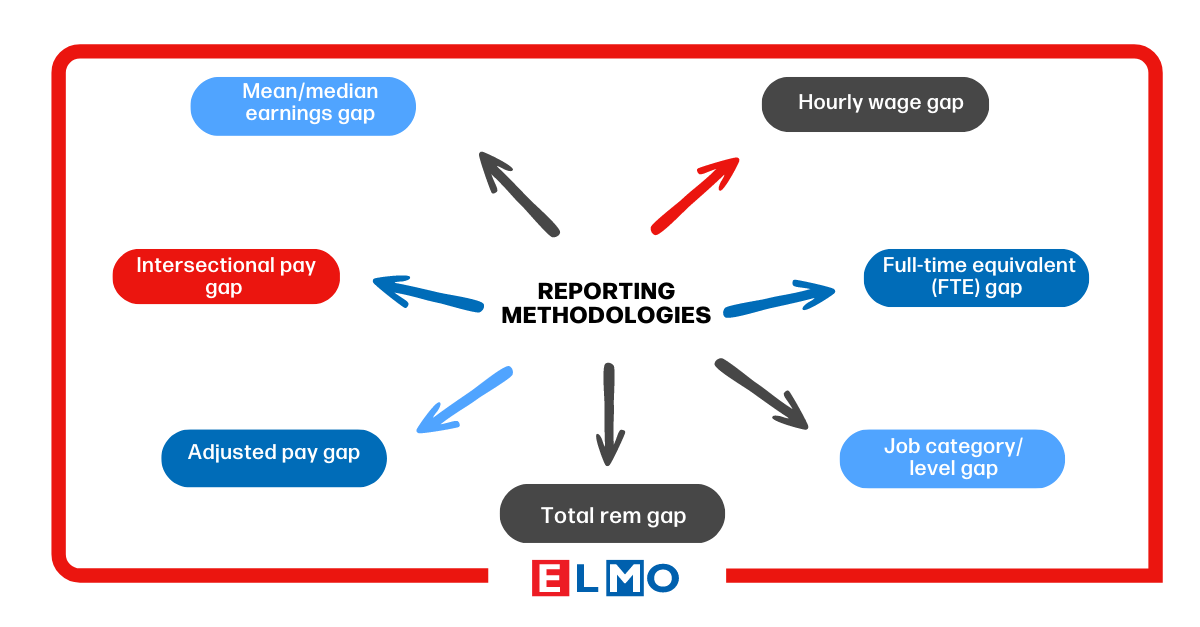Understanding the Gender Pay Gap: An In-Depth Look at Reporting Methodologies

Gender pay gap reporting is an important exercise for shedding light on workplace inequalities. But where should HR professionals start if they want to better understand their organisation’s gap?
One of the first steps is to undertake a gender pay gap audit. In this article, we delve into seven different gender pay gap reporting methodologies that can be used to run a wage gap assessment. By understanding the differences between each methodology, you’ll gain a clearer perspective on which type of gender pay gap reporting framework would be best for your organisation.
Mean/median earnings gap
One commonly used gender pay gap reporting methodology is the mean/median earnings gap. It involves comparing the average or median earnings of men and women within an organisation or industry. By calculating the difference between these figures, we can identify the gender pay gap. While this approach offers a simple and intuitive assessment, it may not account for variations in work hours, job roles, or other relevant factors.
For example, Australia’s National Gender Pay Gap, which uses ABS data, is a comparison of base salary for full-time workers. This means it excludes overtime, bonuses and additional payments. It also excludes the salaries of part-time and casual workers.
Hourly wage gap
To account for discrepancies in working hours, the hourly wage gap methodology is employed. This approach compares the average or median hourly wages of men and women. By focusing on the wage rate per hour, it captures differences caused by part-time employment, overtime pay, and variations in work schedules. This reporting methodology provides a more nuanced understanding of the gender pay gap, particularly in industries or organisations with diverse working arrangements.
Full-time equivalent (FTE) gap
The FTE gap methodology standardises the gender pay gap by considering Full-time equivalent (FTE) employees. It calculates the average or median earnings based on the assumption that all employees work full-time. This approach effectively addresses disparities arising from part-time employment, as it compares earnings as if all employees were working on a full-time basis. By doing so, it provides a more accurate representation of gender pay gap reporting across various work patterns.
The Workplace Gender Equality Agency uses this type of methodology for its annual census data because the calculation includes the annualised full time equivalent salaries of casual and part time workers. It also includes base salary, overtime, bonuses and additional payments.

Job category/level gap
The job category/level gap methodology examines gender pay disparities within specific occupational groups or job levels. It compares the average or median earnings of men and women in similar roles, offering insights into discrepancies within specific job categories. This approach helps identify potential barriers or biases within particular sectors, highlighting areas where gender equality measures need to be strengthened.
Adjusted pay gap
The adjusted pay gap methodology goes beyond simple earnings comparisons by accounting for various factors that influence pay differentials. It considers variables such as education, experience, and job tenure through statistical modelling. By estimating the pay gap after controlling for these variables, it offers a more comprehensive understanding of the gender pay gap. This methodology helps differentiate between pay disparities caused by factors unrelated to gender, such as differences in qualifications or experience, and those resulting from gender-based discrimination.
Read more: Tackling the Gender Pay Gap: 5 Causes of Pay Inequality
Intersectional pay gap
Recognising that gender intersects with other dimensions of identity, the intersectional pay gap methodology examines disparities considering multiple factors, such as race or ethnicity. This approach allows us to explore how different identities intersect and influence earnings inequalities. By understanding the interplay between various forms of discrimination, organisations can implement targeted strategies to address overlapping inequalities and promote more inclusive workplaces.
Total remuneration gap
The total remuneration gap methodology takes into account all elements of compensation, including bonuses, benefits, stock options, and other forms of remuneration. It offers a comprehensive view of the gender pay gap, going beyond basic salaries. By analysing the complete compensation package, organisations can assess whether gender-based disparities exist in areas beyond direct earnings. This methodology provides a holistic understanding of the gender pay gap and helps drive efforts to rectify disparities in all aspects of remuneration.
Effective reporting methodologies are crucial to address the gender pay gap. By understanding and utilising these methodologies, organisations can uncover the complexities of wage disparities. Take steps towards creating inclusive workplaces and promoting gender equality by implementing data-driven strategies based on these insights.
How can technology help?
ELMO Remuneration is a best-in-class solution to help you manage the critical business process of pay reviews, ensuring that your budget is effectively managed, and your data is secure.
The system is gender and diversity agnostic, meaning it provides recommendations based on individual needs, performance, and Compa-ratio (a measure against the market) or any other components that are useful for budget allocation.
To reduce bias, the system can incorporate rules set by the admin. This allows users to easily implement a gender parity policy across an organisation, aligning pay rises and bonuses with your key remuneration initiatives.
Want to keep up-to-date with ELMO’s content? Subscribe to our newsletter for first-look access to our free research, blogs, and resources.
 HR Core
HR Core 









